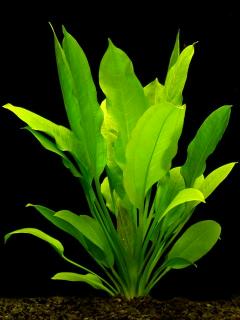 Live plants are to the freshwater aquarist what live corals are to the saltwater reef aquarist. They add a natural look to the tank, can benefit the water quality and other livestock and can be a challenge to maintain and “aqua-scape” into just the right look for the aquarium. Just as corals need to be placed in the right area of the aquarium and secured correctly so they can remain healthy and thriving, so also do plants need to be planted correctly and appropriately. Knowing how to best plant different types of live plants that you may have will help them thrive. Keep in mind however that these are general guidelines. Some plants prefer larger or smaller substrates or may have special considerations for their species.
Live plants are to the freshwater aquarist what live corals are to the saltwater reef aquarist. They add a natural look to the tank, can benefit the water quality and other livestock and can be a challenge to maintain and “aqua-scape” into just the right look for the aquarium. Just as corals need to be placed in the right area of the aquarium and secured correctly so they can remain healthy and thriving, so also do plants need to be planted correctly and appropriately. Knowing how to best plant different types of live plants that you may have will help them thrive. Keep in mind however that these are general guidelines. Some plants prefer larger or smaller substrates or may have special considerations for their species.
Bunched Plants
Bunched plants are popular and common. Though their appearance, care and requirements vary, “bunched plants” are all sold as bundled individual stem cuttings held together with a metal plant anchor or rubber band. These plants generally root within a week or two and the growing tips can be pruned and replanted to make new plants. Some bunched plants like hornwort an anacharis, can be left floating on the water’s surface. You can plant each stem of a bunch individually by inserting the end into the substrate, or keep them in their bunches for a bushier look. The plant anchors or rubber bands can be removed once the plant is rooted in place. Read More »
 That Fish Blog – Aquarium Advice and Information
That Fish Blog – Aquarium Advice and Information

 Members of the Cryptocoryne genus are well known and well established within the aquarium hobby. The most popular of the Crypts, Cryptocoryne wendtii, is tolerant of lower light, higher heat, and just about anything else you can throw at it. Though there are some types that can be tricky to keep, the species that are regularly available to hobbyists are certainly considered to be among the most reliable and versatile plants around.
Members of the Cryptocoryne genus are well known and well established within the aquarium hobby. The most popular of the Crypts, Cryptocoryne wendtii, is tolerant of lower light, higher heat, and just about anything else you can throw at it. Though there are some types that can be tricky to keep, the species that are regularly available to hobbyists are certainly considered to be among the most reliable and versatile plants around.  Hello, Craig here again! With 15 years on the retail side of this hobby, I have been asked a lot of questions, many of which have been centered on the well-being and growth of live plants for the freshwater aquarium. In my next couple of entries, I thought I would explore some frequently asked questions about
Hello, Craig here again! With 15 years on the retail side of this hobby, I have been asked a lot of questions, many of which have been centered on the well-being and growth of live plants for the freshwater aquarium. In my next couple of entries, I thought I would explore some frequently asked questions about